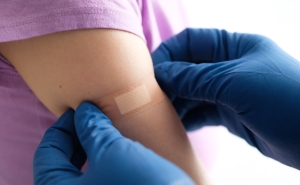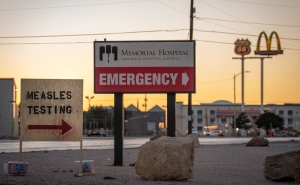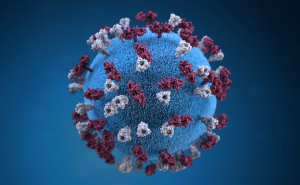Do COVID’s Origins Matter?
We should work to minimize lab leaks and spillover risks, regardless of what started the pandemic.

Three years into the COVID-19 pandemic, it’s still not known whether the pandemic was caused by a natural spillover of the coronavirus from animals to humans or by a leak of the virus from a Chinese lab.
In this Q&A, adapted from the March 29 episode of Public Health On Call, Stephanie Desmon talks to Tom Inglesby, MD, director of the Johns Hopkins Center for Health Security, about the dueling theories on where COVID came from. They discuss what we know, why it matters, and what lessons we can learn for the future.
Public Health On Call
This article was adapted from the March 29 episode of Public Health On Call Podcast.
Three years into the COVID-19 pandemic, we are still debating whether it started with a natural spillover event or a lab leak. What are the merits of each of those theories?
The basis for the first one—that a virus circulating in the animal population “spilled over” into humans—is that about 75% of emerging infectious diseases are found to have spilled over from an animal. In the large outbreak of SARS-CoV-1, for example, civets were determined to be the source animal for the spillover. So that’s certainly a very legitimate concern.
The second possibility is that something happened involving a human accident—either scientists brought the virus from nature into the laboratory and accidentally infected someone who then spread it, or the virus was changed in some way in the lab that then led to the infection of a human and it spread from there. So when people say the laboratory was the source of infection, they mean something human-generated that was not intended.
Why are we still talking about this?
The problem is that we have lots of missing data from the earliest days of the pandemic. We don’t have good epidemiologic data. We don’t have good hospital data. We didn’t have access to the laboratories where people were working on coronaviruses. Some of the data has been withheld; some has been destroyed. And that absence or paucity of data has led to lots of uncertainty. So, each time a new fact emerges, there’s a lot of attention placed on that fact or that new piece of data.
But at this point, at least in my view, we don’t have a strong, conclusive case for either of those explanations. It remains an open question that is quite animating for people: What was the cause of this terrible pandemic event and how can we get to the bottom of it? Can we get new information, new data, primarily from scientists from China, but perhaps in other databases in the world as well?
Knowing that either case is possible, should we just focus on how to make them both less likely to happen?
Many people have called on governments and the scientific community to act as if both of those things were the cause and do whatever necessary to increase laboratory safety and to change animal husbandry practices, perhaps in wet markets, or consider ways that we interact with the ecosystem and proximity to animals that carry viruses that could spillover.
I think that if we had more certainty or closer to conclusive evidence, there would be more international resolve to get all those things done. But we should be acting as if we’re not going to get to the bottom of it and just start making sure we do everything we can to prevent something like this from happening again.
Congress is now having hearings on the origins of COVID. Do you think it’s important that they pursue this?
I think we should be open to and continue to seek information and facts about what happened. But some of the ways it’s being pursued are very destructive. It’s personal. It has caused risks to individuals. It’s distracting to many scientists who are targeted on social media. And I don’t think that’s going to help us get to the bottom of things at all. It’s going to actually create larger political divides and slow us down.
But I don’t think that should stop us from a dispassionate look for facts. The intelligence agencies, for example, have been working to develop the fact basis for both theories. In many ways, they could be a model for what we do.
Tell me about the recent discovery that perhaps a raccoon dog is the source of the virus, and what that means as far as tipping the balance in this conversation.
One of the challenges is that developments around COVID’s origins are often presented in a media channel that is not a scientific journal. When you read a story in a popular news journal, it doesn’t usually contain much scientific evidence at all, so what you hear are very high-level summaries that may be selectively presented.
In this case, all we have is an account from news outlets that in one or more of the samples taken from the market in Wuhan, there was evidence of raccoon dog genetic material in the same swab as evidence of SARS-CoV-2 virus. Some have argued that that is evidence that the raccoon dog is the missing link or in some way related to spillover.
But other scientists would say that human genetic material as well as other animals’ genetic material has also been recovered with SARS-CoV-2 from the same market. So it’s not clear to me what’s particularly special about this new discovery.
It’s important to know that this genetic material was found, but it doesn’t say that the raccoon dog was even actually infected, and even if it were infected, we know that many animals were able to be infected by SARS-CoV-2. So it doesn’t rule out the possibility that humans infected the raccoon dog in the market. Maybe we’ll learn more when the science is presented in the scientific paper.
Is China’s unwillingness to share what they know part of the reason that we may never get to the bottom of this?
At this point, unfortunately, the Chinese government has not allowed a lot of information to be released, and they’re not allowing Chinese scientists to publish science around this. You might think that there would be a whole legion of scientific papers coming out to present various cases, but that’s not happening at all. Hopefully that will change. There is a lot of missing data— about cases, timelines, and epidemiologic information about the pattern of the virus in the earliest days—and the Chinese government has control over that data.
So what do you think happened?
I don’t know. I am open to both possibilities—either natural spillover or a laboratory problem that occurred somewhere along the chain.
What’s the lesson in this whole debate over the beginning of the pandemic?
One of the lessons is that we should have international teams working on origin questions from the earliest days of future epidemics and pandemics. We should be prepared to go in with all of the right scientific capabilities to get to the bottom of things as quickly as possible, because the more time that passes, the colder the scientific record, the forensic record, and the data. So we should do whatever we can to commit to sharing data and having international expertise brought to bear in the earliest days.
Stephanie Desmon is the co-host of the Public Health On Call podcast. She is the director of public relations and marketing for the Johns Hopkins Center for Communication Programs, the largest center at the Johns Hopkins Bloomberg School of Public Health.





